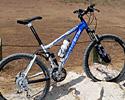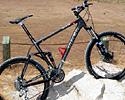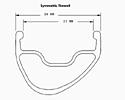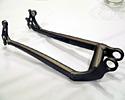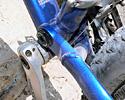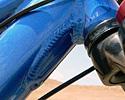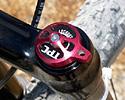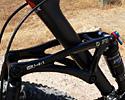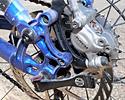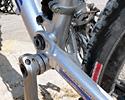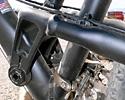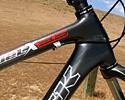
Recently on Cyclingnews.com |
Tech Feature: Trek revamps mountain bike lineup for 2007; July 7, 2006
Drawing on the past; looking to the future, part 2: Racing Fuel & wider rims
In the second part of our look at Trek's 2007 off-road range, James Huang explores the new Fuel XC bikes, checks out Bontrager's new rims and hits the trail on the new machines. Part one is here.
Trek expands Top Fuel and Fuel EX lineups
Trek's Top Fuel line has been expanded to five models for '07 which now includes lower price-point aluminum model as well as a top-end superlight carbon version which reputedly weighs less than 20lb. The OCLV 110 carbon frames receive a new one-piece top tube/head tube, similar to that used on the road going Madone, as well as a new OCLV carbon bottom bracket lug. Aluminum models use the company's proprietary ZR9000 aluminum tubing which is heavily shaped for rigidity and strength. All Top Fuel bikes will sport 90mm of rear wheel travel and are designed around 100mm travel forks. In a nod to the bikes' race-orientated riders, bottom bracket shell widths have also been downsized to 68mm to facilitate the use of narrower a 2x9 drivetrain.
By its own admission, Trek's new "R1 Tuned Suspension" system is more of an evolutionary progression rather than a wholly new offering as all models use the same basic modified single pivot-plus-rocker link layout that has been used since the introduction of the original Fuel. However, although the layout remains the same, little else does. Sealed cartridge bearings are now used at each pivot for enhanced durability and a reported 66 percent improvement in small bump sensitivity. Trek paid considerable attention to the main pivot in particular, which now uses press-fit oversized bearings that are set in a new 'Wide Stance' spacing for better swingarm rigidity. In addition, new welded aluminum HiLo asymmetric chainstays help to yield a 200g weight savings as compared to last year's assemblies. In spite of its decidedly racer-oriented intent, the new rear end also provides more clearance with room for up to 2.5in rubber.
As with the Top Fuel, the Fuel EX family has grown significantly and now includes eight models, including two women's-specific versions. Upper-end versions get a travel increase for '07, and now have 120mm of rear travel and 130mm travel forks, while lower price point models retain the 100mm of travel from the previous year. Better component specifications have dropped the weights dramatically across the board, most notably in the aluminum Fuel EX 8 which has shed a full 2lb relative to the '06 model.
The frames themselves are also lighter and include new asymmetric ZR9000 rear triangles using the same Wide Stance bearing spacing and press-fit oversized sealed cartridge bearings as on the Top Fuel. Fuel EX rear ends also receive proper seatstay-located dropout pivots improve small bump compliance and also remove any built-in "springiness" that existed in the old rear end for more precise tuning.
Bontrager grows both taller and wider
As is the case with the new Gary Fisher and Trek mountain bike models, Bontrager's wheel division also continues its development of components for the 29er market. Last year's Race Lite 29 wheelset has now been eclipsed with the advent of a Race X Lite version. The new upper-end offering sports a tubeless-ready 475g rim laced with 14/16g double-butted DT spokes to a pair of hubs based on DT Swiss' top-end 240 design. Naturally, Bontrager will offer several new tubeless-ready 29er tires to mount on the new hoops, including its extant Jones ACX and Jones XR tread patterns as well as a new Dry X. When combined with Bontrager's Super Juice sealant, the new wheel and tire combo is said to drop a whopping 315g from last year's Race Lite 29 wheelset and standard tubed tires.
Bontrager also gains a bit of girth around the middle with the introduction of its Rhythm wheels. According to Bontrager, Rhythm was conceived specifically to be used with today's wider (2.2in and up) tires and incorporates its first all-new rim extrusion in years. The 28mm rim width is said to offer better sidewall support as well as a larger and more stable contact patch than the current 23mm standard and also uses an offset spoke bed for more even spoke tension. In spite of the added width, the rim is still reported to weigh only 440g, complete with eyelets. An optional airtight rim strip will enable tubeless-compatibility and two Rhythm versions will be available in both standard quick-release and 20mm thru-axle varieties.
Time to hit the dirt
Naturally, trail time is the ultimate test of a bike's performance and there was plenty available in the areas surrounding Grand Junction where a fleet of Trek Travel vehicles were on hand to whisk us all away (including John Burke!) to the Kokopelli and 18 Mile Road trails to briefly test the HiFi, Supercaliber 29er, Top Fuel, and Fuel EX.
Although the single-pivot designs look humble on paper, Trek has obviously done its homework to extract as much performance as possible as each of the bikes rode and pedaled surprisingly well. Single-pivot still rules the nest in Waterloo, but the talons have grown longer and sharper. For starters, the bearing-equipped rear end of the Top Fuel was noticeably smoother than in previous iterations, and the Race Day platform definitely satisfies its go-fast goal with its firm and limited travel.
The star of the show, though, was the Gary Fisher HiFi with its featherlight 5in-travel chassis and nimble handling. Under power, the HiFi pedaled startlingly efficiently and Genesis 2.0 seems to work as advertised as there was a marked improvement in low-speed handling over the original Genesis geometry. Granted, it should be noted that none of the trails we visited justified leaving the middle ring where each system was optimized nor was there heavy braking involved so we'll reserve final judgment until we're able to put in some more quality time.
Overall, the new lineup is certainly promising. While the lack of an innovative new rear suspension design is still somewhat disappointing, Trek seems to have proved that simple can still be effective. If nothing else, the newfound commitment to the off-road world is a refreshing change from years of Lance Fever and the Travis Brown-signature 69er shows that Trek is at least willing to go out on limb a bit. As Burke mentioned in his opening speech, "this is just the start", and it will be interesting to see how things continue to develop. Welcome back, Trek. We missed you.
Photography
For a thumbnail gallery of these images, click here
Images by James Huang/Cyclingnews
- Trek’s new HiLo chainstay assemblies allegedly save up to 200g over last year’s setups.
- Remember this? Unfortunately, the RS-1, designed by Mert Lawill and fine-tuned to perfection by Gary Fisher, was way ahead of its time and lacked component support to make it stick.
- Er… maybe Trek should have left this one at home…
- Now this is what I call a roof rack. Thought you had a stacked setup? Think again. Trek Travel’s crew can not only haul a bunch of bikes but can also arrange a mean trailside lunch.
- The new Gary Fisher HiFi sports 120mm of travel in a frame weighing under 2.4kg.
- Dropout pivots on the new HiFi are located on the seatstay instead of the chainstay (which would require a license from rival Specialized), effectively making the rear end a single pivot design.
- Even the clean downtube gusset on the HiFi is machined for weight savings.
- Fox Racing Shox’s wares gain much more prevalent spec on Trek’s lineups for ’07, particularly at the high end.
- Widely spaced oversized main pivot bearings offer good support to the rear swingarm.
- Check out the slick-looking non-driveside dropout on the HiFi. Nicely done.
- Gary Fisher worked closely with Manitou and Bontrager to develop the new Genesis 2.0 geometry. Custom-offset Manitou Minutes will grace the upper end HiFi trail bikes.
- The HiFi Pro uses a tidy-looking, bearing-equipped linkage to drive the Fox RP23 rear shock.
- CNC machines make a comeback for ’07? Interestingly enough, the new Minute crown looks awfully similar (stylistically) to my old Rock Shox SID crown!
- Trek’s top-of-the-line Fuel EX receives a new OCLV frame, substantially lighter rear end, and a wealth of premium kit including a Fox fork up front.
- New forged aluminum rockers on the Fuel EX are carved out to reduce weight yet are still fully bearing-equipped for smooth operation.
- The bottom end of the Fuel EX is particularly tidy-looking. Wide Stance main pivot bearing spacing provides better support for the rear end.
- The ’07 Fuel EX receives a proper dropout pivot to remove any built-in “springiness” from the system for more accurate suspension tuning.
- The ’07 carbon Fuel EX utilizes a one-piece top tube/head tube construction similar to that used in the roadgoing Madone.
- Upper-end Fuel EX models receive heavy suspension spec from Fox Racing Shox.
- Trek’s Top Fuel lineup now includes aluminum-framed models for the first time. Extensive hydroforming is used to shape the ZR9000 tubeset.
- No head tube gusset required here due to the careful down tube shaping.
- Trek’s Top Fuel uses new forged aluminum rocker links to drive the rear shock.
- Main pivot on the new Top Fuel receives Wide Stance bearing spacing and press-fit oversized cartridge bearings. Chainstays are asymmetric to maximum the efficient use of material.
- Manitou also receives greater OEM spec on Trek’s ’07 lineup, including the S-Type shock seen on this aluminum Top Fuel.
- Gary Fisher continues to support the 29er scene with the development of a 29in version of the Race Day short-travel XC platform.
- Simple but effective - the Supercaliber’s single-pivot rear suspension layout is primitive on paper, but proved quite capable in practice on the trail.
- Large diameter, swingarm-located cartridge bearings provide lateral support for the rear end. Narrow 68mm bottom bracket shell makes for easier 2x9 conversions and tighter q-factors.
- Rock Shox’s Reba continues to dominate the 29er fork market. Anyone else want to step up to the plate?
- Wider is better - at least as far as rims are concerned when using bigger tires. Bontrager’s new Rhythm rim measures a full 28mm wide yet still tips the scales at only 440g including eyelets.
- The top tube decal on Gary Fisher’s own test rig seemed a bit superfluous, wouldn’t you say?
- Mr. Trek made it out on the trail with us, but admitted to crashing “four and a half times”, thus explaining the dirt on his back.
- A quick transfer over to Crested Butte included a trip to the Mountain Bike Hall of Fame.

